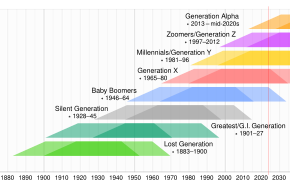
Back طفرة المواليد Arabic Baby boomer AST Baby boomers BCL Baby boomers Catalan Generace Baby boomers Czech Babyboomer-generationen Danish Baby-Boomer German Μπέιμπι μπούμερ Greek Bumeroj Esperanto Baby boomer Spanish
| Part of a series on |
| Social generations of the Western world |
|---|
 |
This article may be too long to read and navigate comfortably. (November 2024) |
Baby boomers, often shortened to boomers, are the demographic cohort preceded by the Silent Generation and followed by Generation X. The generation is often defined as people born from 1946 to 1964 during the mid-20th century baby boom. By this dating, the youngest of them are 60, while the oldest are 79. The dates, the demographic context, and the cultural identifiers may vary by country.[1][2][3][4] Most baby boomers are the children of either the Greatest Generation or the Silent Generation, and are often the parents of the younger members of Generation X and Millennials.[5] In the West, boomers' childhoods in the 1950s and 1960s had significant reforms in education, both as part of the ideological confrontation that was the Cold War,[6][7] and as a continuation of the interwar period.[8][9] Theirs was a time of economic prosperity and rapid technological progress.[10] As this relatively large number of young people entered their teens and young adulthood—the oldest turned 18 in 1964, the youngest in 1982—they, and those around them, created a very specific rhetoric around their cohort,[11] and the social movements brought about by their size in numbers, such as the counterculture of the 1960s[12] and its backlash.[13]
In many countries, this period was one of deep political instability due to the postwar youth bulge.[13][14] In China, boomers lived through the Cultural Revolution and were subject to the one-child policy as adults.[15] These social changes and rhetoric had an important impact in the perceptions of the boomers, as well as society's increasingly common tendency to define the world in terms of generations, which was a relatively new phenomenon. This group reached puberty and maximum height earlier than previous generations.[16]
In Europe and North America, many boomers came of age in a time of increasing affluence and widespread government subsidies in postwar housing and education,[17] and grew up genuinely expecting the world to improve with time.[18] Those with higher standards of living and educational levels were often the most demanding of betterment.[13][19] In the early 21st century, baby boomers in some developed countries are the single biggest cohort in their societies due to sub-replacement fertility and population aging.[20] In the United States, they are the second most numerous age demographic after millennials.[21]
- ^ Owram, Doug (December 31, 1997). Born at the Right Time. Toronto: University of Toronto Press. doi:10.3138/9781442657106. ISBN 978-1-4426-5710-6.
- ^ Little, Bruce; Foot, David K.; Stoffman, Daniel (1998). "Boom, Bust & Echo: How to Profit from the Coming Demographic Shift". Foreign Policy (113): 110. doi:10.2307/1149238. ISSN 0015-7228. JSTOR 1149238.
- ^ Salt, Bernard (2004). The Big Shift. South Yarra, Victoria: Hardie Grant Books. ISBN 978-1-74066-188-1.
- ^ Cite error: The named reference
Delaunay-2019was invoked but never defined (see the help page). - ^ Rebecca Leung (September 4, 2005). "The Echo Boomers – 60 Minutes". CBS News. Archived from the original on November 4, 2013. Retrieved August 24, 2010.
- ^ Cite error: The named reference
Stroke-2013was invoked but never defined (see the help page). - ^ Cite error: The named reference
Knudson-201dwas invoked but never defined (see the help page). - ^ Cite error: The named reference
Garraty-1991was invoked but never defined (see the help page). - ^ Cite error: The named reference
Gispertwas invoked but never defined (see the help page). - ^ Cite error: The named reference
Twenge-2023awas invoked but never defined (see the help page). - ^ Pinker, Steven (2011). The Better Angels Of Our Nature. Penguin. p. 109. ISBN 978-0-141-03464-5.
- ^ Owram, Doug (1997). Born at the Right Time. Toronto: University of Toronto Press. p. xi. ISBN 978-0-8020-8086-8.
- ^ a b c Cite error: The named reference
Suri-2009was invoked but never defined (see the help page). - ^ Cite error: The named reference
Turchin-2010was invoked but never defined (see the help page). - ^ Woodruff, Judy; French, Howard (August 1, 2016). "The unprecedented aging crisis that's about to hit China". PBS Newshour. Archived from the original on September 26, 2020. Retrieved August 13, 2020.
- ^ Cite error: The named reference
Hobsbawn-1996bwas invoked but never defined (see the help page). - ^ Owram, Doug (1997). Born at the Right Time. Toronto: University of Toronto Press. p. x. ISBN 978-0-8020-8086-8.
- ^ Jones, Landon (1980). Great Expectations: America and the Baby Boom Generation. New York: Coward, McCann and Geoghegan.
- ^ Cite error: The named reference
Hobsbawn-1996was invoked but never defined (see the help page). - ^ Zeihan, Peter (2016). "Chapter 5: The End of the (Old) World". The Absent Superpower: The Shale Revolution and a World without America. Austin, TX: Zeihan on Geopolitics. ISBN 978-0-9985052-0-6. Population pyramids of the developed world without the U.S. Archived October 30, 2020, at the Wayback Machine and of the U.S. in 2030 Archived October 10, 2020, at the Wayback Machine.
- ^ Fry, Richard (April 28, 2022). "Millennials overtake Baby Boomers as America's largest generation". Pew Research Center. Archived from the original on April 28, 2020. Retrieved May 31, 2022.